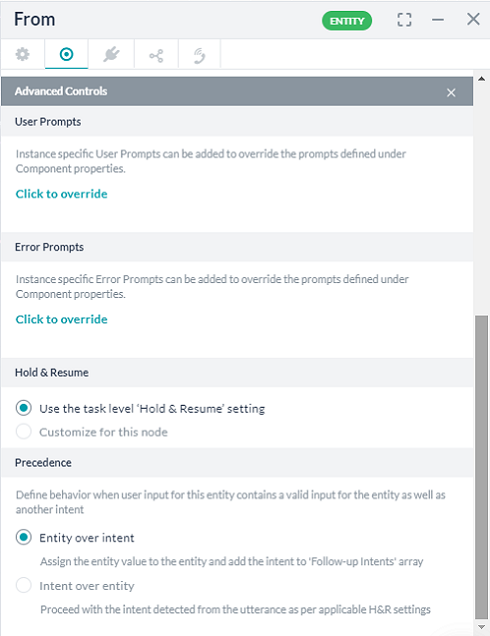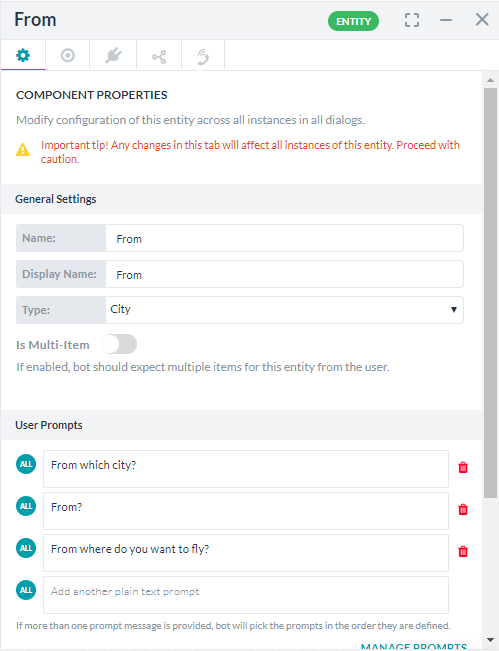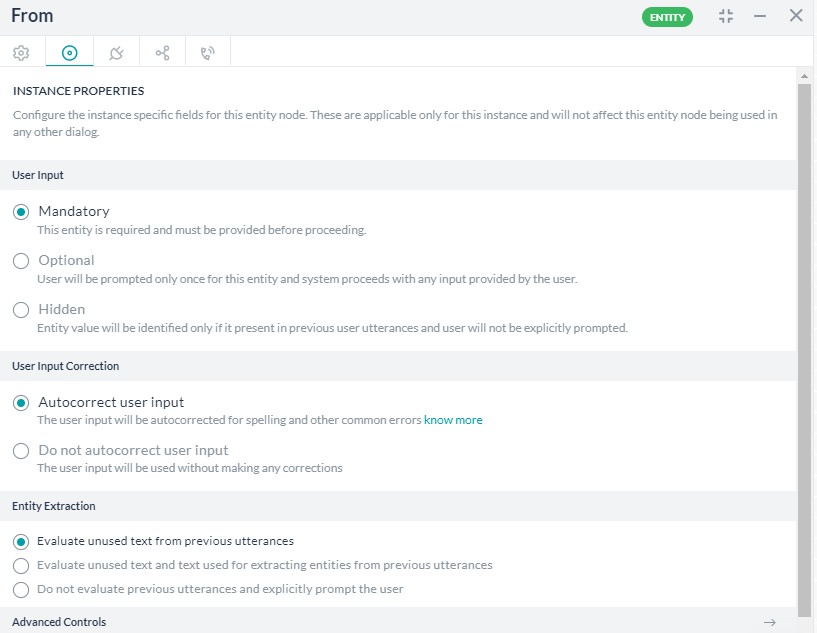Bots need to extract relevant information from the user utterance to fulfill the user intent.
Take a look at this sample utterance: Book me a flight from LA to NYC on Sunday. To act on this user intent, which is to book a flight ticket, the bot should extract the entities such as the source city (LA), destination city (NYC), and the departure date (Sunday).
So, in a Dialog Task, for every critical data you want to get from a user utterance, you should create a corresponding entity node. You can add prompt messages to these nodes for users to input the required values.
Kore.ai supports more than 30 entity types such as Address, Airport, Quantity, and so on. You can also define the entities as a selection from a list, free-form entry, file or image attachment from a user, or as regex expressions.
Set Up an Entity Node
Setting up an entity node in a dialog task involves the following steps:
Add an Entity Node to the Dialog Task
Configure the Component Properties
The Entity window allows you to configure the General Settings, User, and Error Prompts.
- On the Component Properties tab, under the General Settings section, enter a Name and Display Name for the entity node. Entity names cannot have spaces.
- From the Type drop-down list, select an entity type depending on the expected user input. For example, if you want the user to type the departure date, select Date from the drop-down. The platform does the basic validation based upon the Type selected.
The Entity Type provides the NLP Interpreter with the expected type of data from a user utterance to enhance recognition and system performance. For more information, refer to Entity Types - Based on the Type selected, you have an option to set the Entity as Multi-item thereby allowing the user multiple selections.
- Under the User Prompt section, enter the prompt message that you want the user to see for this entity. For example, Enter the Departure Date.
- You can enter channel-specific messages for user prompts. For more information, refer to Using the Prompt Editor.
- You can override the user prompt for this particular instance.
To override,- Click the Settings icon on the right.
- Enable the Override for this instance toggle. Once you enable this option, you can enter the user prompt for this particular instance. Disabling this option would delete the instance-specific prompt and revert it to the component property.
- Under the Error Prompts section, review the default error message, and if required, you can modify the error messages.
- To manage the error messages, click Manage Error Messages. For more information, refer to Using the Prompt Editor.
- You can override the user prompt for this particular instance.
To override, - You can also reorder the error messages. To reorder,
- In the Variable Namespaces section (introduced in v8.0), associate the Variable Namespaces to execute this node and its transitions. This option is visible only when the Variable Namespace is enabled for the bot. You can go with the task level settings or customize it for this node. For more information, refer to Managing Namespace.
Configure the Instance Properties
Use the Instance Properties to determine whether to make the entity value mandatory as well as to choose if you want to consider values from previous user utterances to capture entities.
- On the Entity window, click the Instance Properties tab.
- Under the User Input section, select an option (Refer to the below section for how the entity flow is managed):
- Mandatory: This entity is required, and users must provide a valid entry before proceeding with the dialog flow. A prompt is displayed for the user to resolve in case ambiguous values for the entity are detected in the user utterance.
You can configure the number of times the user would be prompted for this entity value by setting the number of Allowed Retries to any value between 1 and 5, the default being 5.
Further, you can define the bot Behavior on Exceeding Retries, this can be set to trigger End of Dialog or Transition to a Node. This would result in the creation of a Connection Rule called Behavior on Exceeding Retries. The message displayed to the user on exceeding retries can be customized from the Standard Responses, refer here. - Optional: The user is prompted only once for this entity and the system proceeds with any input provided by the user. In case ambiguous values for these optional entities are detected in the User Utterance, then a resolution prompt is displayed allowing the user to pick the correct value.
You can set a value under the Default Value field. This value would be assigned to this entity when the task execution reaches this entity and the user does not provide any value when prompted and if no value is available from previous utterances. - Hidden: If enabled, the bot will not prompt for the entity value. The value would be considered if explicitly provided by the user in previous utterances.
You can set a value under the Default Value field. This value would be assigned to this entity when the task execution reaches this entity and no value is available from previous utterances.
- Mandatory: This entity is required, and users must provide a valid entry before proceeding with the dialog flow. A prompt is displayed for the user to resolve in case ambiguous values for the entity are detected in the user utterance.
- User Input Correction section (v7.3) to define whether the user input needs to be auto-corrected. This option is available only for string type entities. The two options are listed below:
- Auto-correct user input is the default setting. The platform builds a custom dictionary for each bot to include all synonyms, task names, pattern words, and small talk utterance words on top of a standard dictionary. This feature is not supported in all languages, Click here for details.
- Do not auto-correct user input
To ensure backward compatibility, the following settings are applied to existing bots (migrating bots older than v7.3 to v7.3):Old State (Entity Extraction) New State (User Input Correction) Evaluate unused text from previous utterances. Do not auto-correct user input. Evaluate unused text and text used for extracting entities from previous utterances. Do not auto-correct user input. Do not evaluate previous utterances and explicitly prompt the user – Do not auto-correct [Enabled]. Do not auto-correct user input. Do not evaluate previous utterances and explicitly prompt the user – Do not auto-correct [Disabled]. Auto-correct user input.
- Under the Entity Extraction section, select one of these options:
- Evaluate the un-used text from the previous utterance: When this option is selected, the entity uses the text that was not used by any other entity in the dialog so far. This is the default option.
- Evaluate un-used text and text used for extracting entities from previous utterances: Select this option if you want to reuse an entity value extracted by another entity node in the dialog.
- Do not evaluate previous utterances and explicitly prompt the user: Select this option if you want the bot to ignore the previous user utterances and explicitly prompt the user to provide value for the entity.
- Further, you can restrict the platform from reusing the input provided for this entity to extract any other entities by selecting the Do not reuse option.
- Under the Entity Rules section, you can configure rules to validate the user input.
- Use the Add/Customize button to enter a JSON structure for the validation and entity extraction rules. Refer here for the details on entity rules.
- Click the Advanced Controls to set up these options:
- User Prompts: Use the Click to Override button has been moved to Component Properties in v8.1
- Error Prompts: Use the Click to Override button has been moved to Component Properties in v8.1
- Intent Detection (Applies only to String and Description entities): Select one of these options to determine the course of action if the bot encounters an entity as a part of the user entry for the String or Description entities:
- Accept input as entity value and discard intent detected: The bot captures the user entry as a string or description and ignores the intent.
- Prefer user input as intent and proceed with Hold & Resume settings: The user input is considered for intent detection and proceed according to the Hold & Resume settings.
- Ask the user how to proceed: Allow the user to specify if they meant intent or entity.
- Interruptions Behavior: To define the interruption handling at this node. You can select from the below options:
- Use the task level ‘Interruptions Behavior’ setting: The bot refers to the Interruptions Behavior settings set at the dialog task level.
- Customize for this node option: You can customize the Interruptions Behavior settings for this node by selecting this option and configuring the same. Read the Interruption Handling and Context Switching article for more information.
- Precedence (Applies to all Entity types except String and Description nodes): When the user’s input for an entity consists of a valid value for the entity and another intent, you can control the experience by choosing between Intent over Entity or Entity over Intent options. For example, if a Flight Booking bot prompts for the destination and the user enters, Bangalore, how’s the weather there? you get to define how the bot responds in such cases; pick the entity and add the intent to the Follow-up Intents stack or go ahead with the intent first based upon the Interruptions Behavior settings.

-
- Custom Tags: It defines tags to build custom profiles of your bot conversations. Click here for more.
User Input Flow
When a user is prompted for input, the following is the process performed by the platform:
- If the user responds with a valid value, then the entity populates with that value and the dialog flow continues.
- If ambiguous values are identified in the user response, then an ambiguity resolution prompt is displayed.
- If the user responds with an invalid utterance i.e. an utterance that does not contain a valid input for the ambiguity resolution, then:
- If the given value is valid for the entity (any possible value for the entity), it is used for the entity and the conversation is continued.
- If the given value is not valid for the entity and if the value triggers any task intent, faq, or small talk, then:
- The intent is executed as per hold and resume settings and when (and if) the dialog (containing the entity) is resumed, the user is prompted for the entity value.
- If the value does not trigger any task intent, faq, or small talk, the entity is left blank and the conversation is continued from the entity’s transitions.
- If the user exceeds the retry limit, the behavior defined for exceeding retries would be triggered. Note that if this is a child task and the behavior is set to end the dialog then the parent task would also be terminated.
Configure the Connections Properties
From the node’s Connections tab, you can determine which node in the dialog task to execute next. You can write the conditional statements based on the values of any Entity or Context Objects in the dialog task, or you can use intents for transitions.
To setup Component Transitions, follow the below steps:
- Under the Connection Rules section, from the Default drop-down list, you can select a node.
- To configure a conditional flow, click Add IF.
- In case you have enabled the Behavior on Exceeding Entity Retries in the Instance Properties, you would see the Behavior on Exceeding Entity Retries connection rule here.
- Configure the conditional expression based on one of the following criteria:
- Entity: Compare an Entity node in the dialog with a specific value using one of these operators: Exists, Does not Exist, equals to, greater than equals to, less than equals to, not equal to, greater than, and less than. Select the entity, operator using the respective drop-down lists, and type the number in the Value box. For example, PassengerCount (entity) greater than (operator) 5 (specified value).
- Context: Compare a context object in the dialog with a specific value using one of these operators: Exists, Does not Exist, equals to, greater than equals to, less than equals to, not equal to, greater than, and less than. For example, Context.entity.PassengerCount (Context object) greater than (operator) 5 (specified value).
- Intent: Select an intent that matches the next user utterance.
- In the Then go to the drop-down list, select the next node to execute in the dialog flow if the conditional expression succeeds. For example, if the PassengerCount (entity) greater than (operator) 5 (specified value), Then go to Offers (sub-dialog).
- In the Else drop-down list, select the node to execute if the condition fails.
Configure the NLP Properties
- On the NLP Properties tab, under the Suggested Synonyms for the < entity name > section, enter synonyms for your entity.
- Click Enter after each entry to save it. For more information, refer to Managing Synonyms.
- Under the Suggested Patterns for < entity name > section, click + Add Pattern to add new patterns for your entity. The Patterns field is displayed. For more information, refer to Managing Patterns.
- Under the Manage Context section, in the Context Output field, define the context tags to be set in the context when this entity populates.
- You can select Auto emits the entity values captured option as part of the Context Object.
Configure the IVR Properties
You can use this tab to define the input mode, grammar, prompts, and call behavior parameters for this node to use in IVR Channel. You can define this at the node level. Click here for details.
You might want to refer to the following sections:





